Shovel Knight Dig is a vertical platformer that follows the latest escapade of Shovel Knight, the knight in azure armor who goes on treasure-hunting adventures wielding a shovel-shaped blade. His opponents this time around are the Drill Knight and his band of spelunking rogues, the Hexcavators. When Drill Knight absconds with Shovel Knight’s bag of treasure into his subterranean lair, I play as the hero while he dives down the pit in pursuit, not knowing the writhing danger that lurks in the bag of stolen gems.
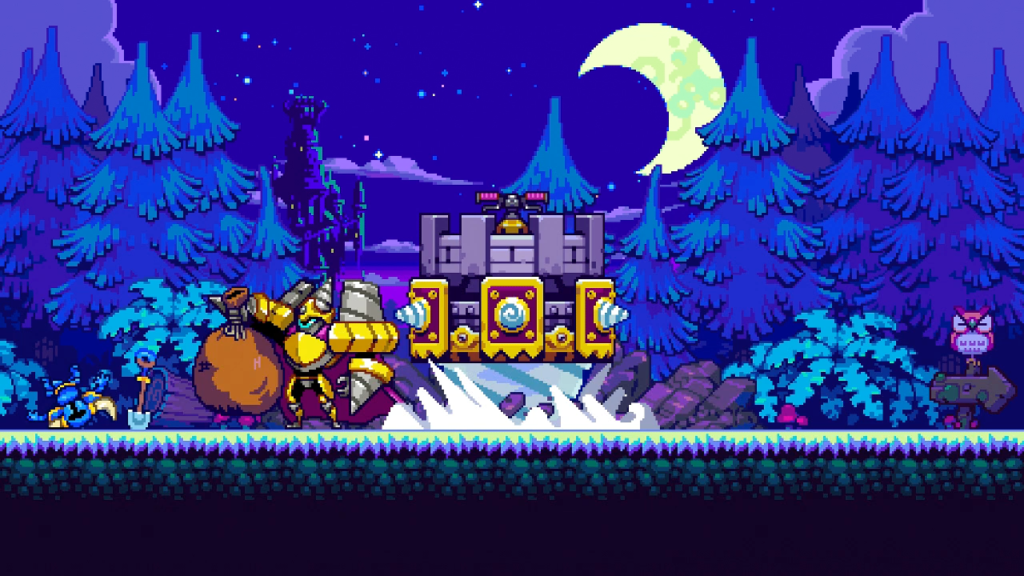
Shovel Knight Dig contrasts most platformers, especially Shovel Knight’s first adventure in Shovel of Hope, by setting its platforming not from the left side of a level to the right, but from the top of a scrolling vertical tunnel to the bottom. I guide Shovel Knight down the tunnel by moving him back and forth across the screen, jumping over obstacles and digging through veins of earth to reach new passages downward.
When Shovel Knight encounters one of Drill Knight’s many minions, he can swing his shovel blade like a sword or use it to bounce off enemy heads. If I’m quick and skillful with the controls, he can bounce between multiple enemy heads. It’s the same straightforward and competent platforming design that was exemplified by the earlier Shovel Knight adventures. The only change is which direction his momentum carries him.
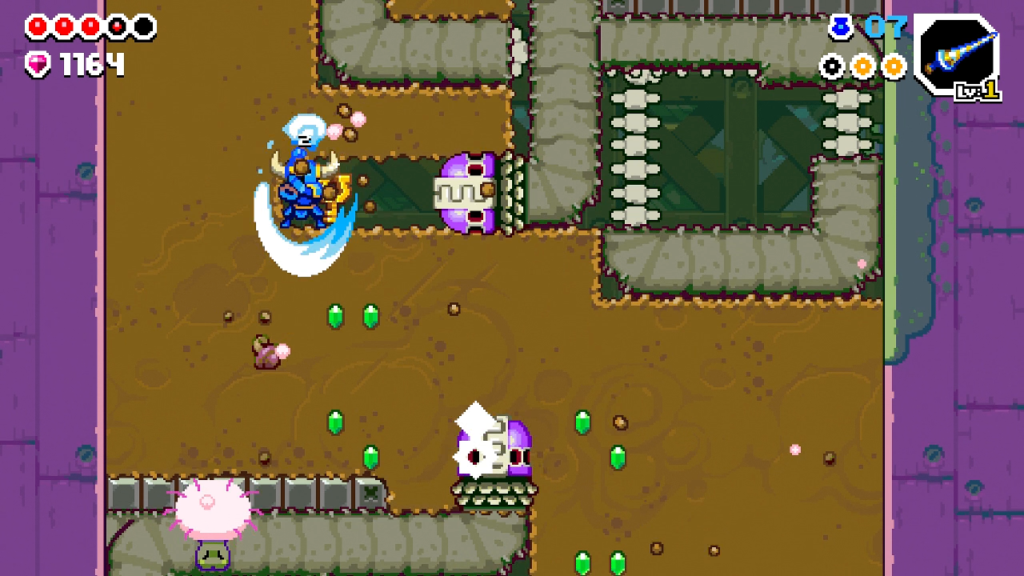
As I guide Shovel Knight down the tunnel, he comes across passageways along the left and right walls. Some of them are open right away, beckoning him inside with a friendly lantern hanging above their entrances. Others are hidden until Shovel Knight taps the wall with the shovel blade, their presence hinted at by subtle clues in the tunnel wall’s surface. These passageways lead to side chambers containing single-screen platforming challenges, echoing the hidden rooms that were prominent in Shovel of Hope. These side chambers are filled with food, magical relics, and helpful NPCs. The dangers in the Hexcavators’ Lair grow in frequency and menace the deeper Shovel Knight descends, so he must gather as many as he can to keep up with their tenacity.
The necessity of collecting these upgrades are where I encounter much of my difficulty in playing Dig. It’s distressingly easy to become trapped in some of the side chambers. Sometimes a certain relic is needed to gain a little extra jumping power to reach a door. If Shovel Knight is out of magic to use that relic, there’s nothing I can do. On another occasion, an exit door seals itself until every enemy in the room is defeated. The last enemy proceeds to path off the screen’s bottom, never to return, forcing me to quit to the main menu.
Shovel Knight Dig does not save after every floor. If I have to restart because Shovel Knight becomes trapped or because the videogame crashes, and in neither case through no fault of my own, then I’m restarting from floor one.
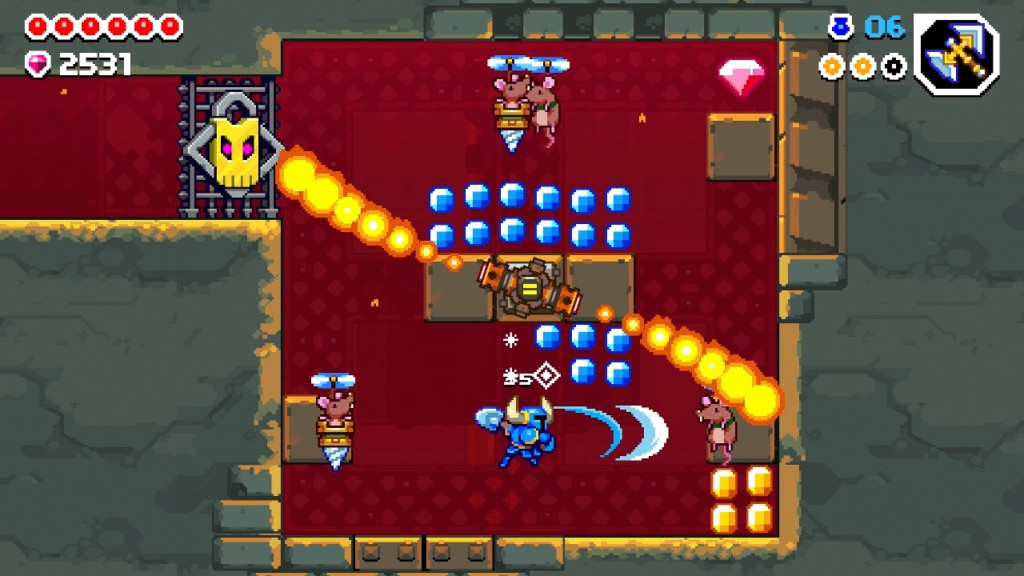
What truly sets Dig apart from Shovel Knight’s first adventure is its randomly-constructed nature. Each level consists of segments drawn at random from a pool of pre-assembled options, stacked on top of each other in a deadly tower. This lets me experience a fresh adventure every time I play without giving up the series’ incredible signature hand-crafted level design. Which pool a segment is drawn from is unique to the level Shovel Knight is in, and there is a respectable array of options.
The first level Shovel Knight visits is always the Mushroom Mines. Obstacles to overcome here include bouncy mushrooms which can send the hero flying into deadly hazards as well as floating spores which shrink him to a fraction of his regular size. Beyond the Mushroom Mines are more varied areas, and I am afforded more agency in determining which of them Shovel Knight visits.
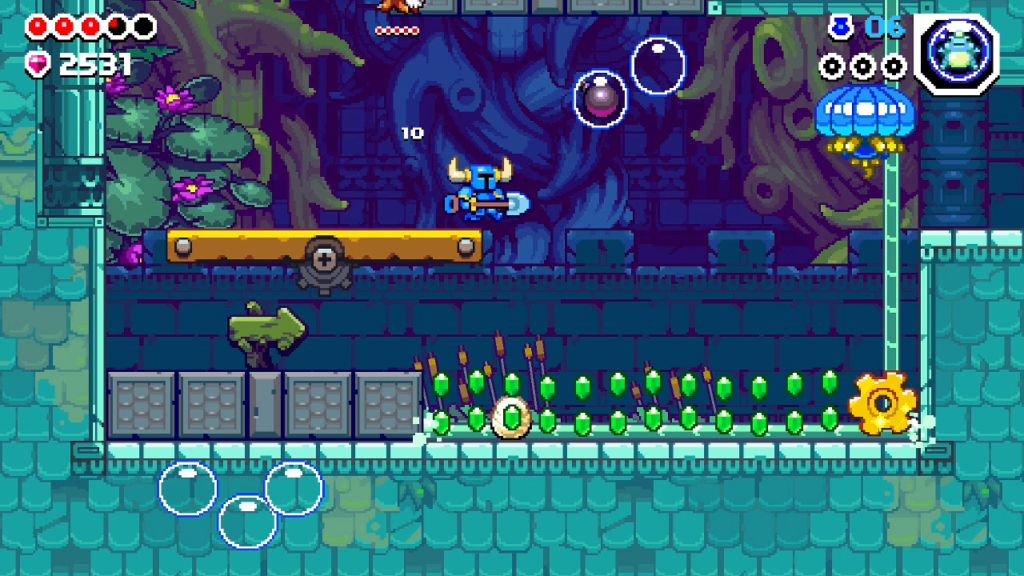
The Secret Fountain is a ruined aqueduct where waterfalls can push items, enemies, and Shovel Knight in inconvenient directions. The Magic Landfill is a garbage dump filled with broken and abandoned magical objects, including portals that must be thoughtfully navigated to proceed beyond seemingly solid barriers. Capping each run is Drill Knight’s Castle, a subterranean fortress filled with mechanical death traps and automated defenses.
Every level is bright and colorful, filled with movement and energy that does justice to Dig’s 16-bit inspirations in the same way Shovel of Hope evokes and embellishes the 8-bit era of platformers.
Every three floors, Shovel Knight faces one of the Hexcavators who guard his stolen bag of loot. Unlike Dig’s level design, these bosses would be right at home in Shovel of Hope—including the same frustrations. Shovel Knight’s blade has a distressingly short range which is manageable against small enemies with limited life bars, but begins to feel like a real liability against large enemies with hit point meters to match. Aggression is counterproductive in these duels. They require swift, precise, and careful application of the shovel blade’s limited abilities.
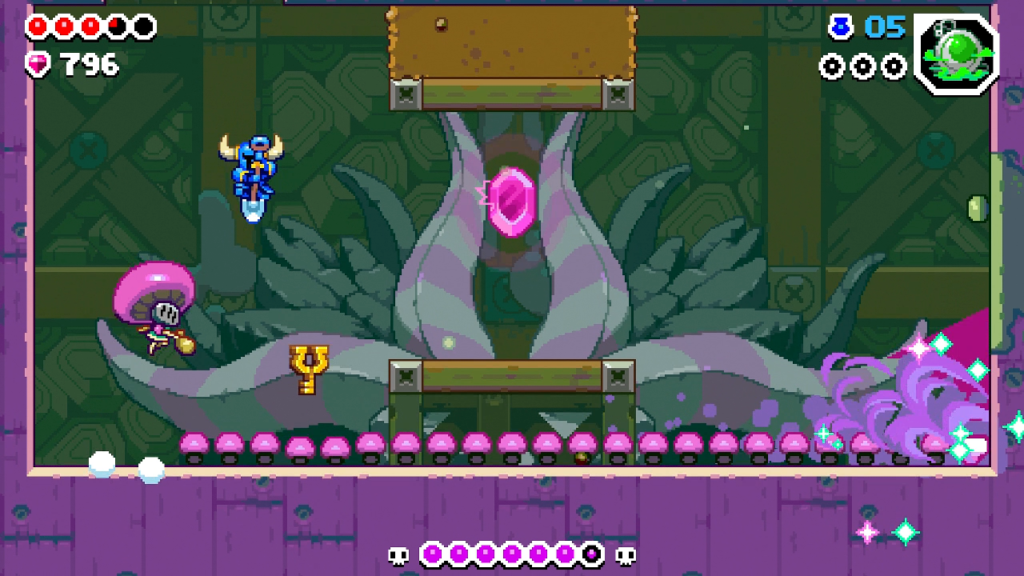
When Shovel Knight dies, a portion of his accumulated gems are dropped, but the rest is carried back to the surface. Here he can visit screens to the left and right of the tunnel entrance where I can spend his riches on new relics and accessories that may appear on future visits to the Hexcavators’ Lair.
A more interesting challenge is presented by the Relic Keys which are sold by Hoofman, a dandy horse merchant. Available only in Hoofman’s Shop for an escalating price, carrying a Relic Key into the Hexcavators’ Lair causes a locked door to appear somewhere in the world. Opening this door with the key and completing the challenge within adds a new powerful Relic to the pool which may appear on my next attempt. Reaching this door with the Relic Key intact proves an increasingly difficult and expensive challenge as the door appears deeper and deeper in the dungeon, requiring me to overcome more and more obstacles to reach the challenge.
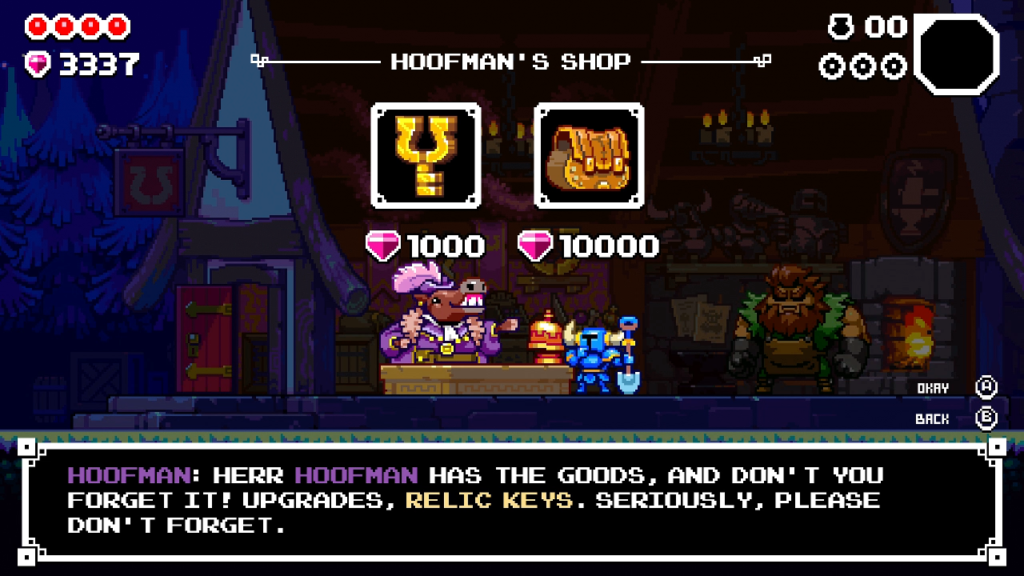
I have many, many opportunities to spend Shovel Knight’s accumulated wealth because I will guide him to his death a lot. Dig is by far the hardest challenge this character has yet faced for a variety of reasons.
Though Dig’s levels do not autoscroll, I am still filled with a sense of urgency because of the Omega Saw. A massive burrowing machine equipped with spinning diamond-tipped sawblades, it appears from the top of the screen and lunges towards Shovel Knight if I do not keep him moving through the level (thankfully, it does not appear in the side chambers). A single blow from the Omega Saw is fatal, making it an effective motivator to keep Shovel Knight pressing downward.
Sometimes it is necessary to risk the Omega Saw’s wrath. Dense gem clusters may give me a reason to hang around an area hoping to gather them all. More often, it appears because of a tricky timing puzzle or precision platforming section that takes me a few attempts to accomplish.
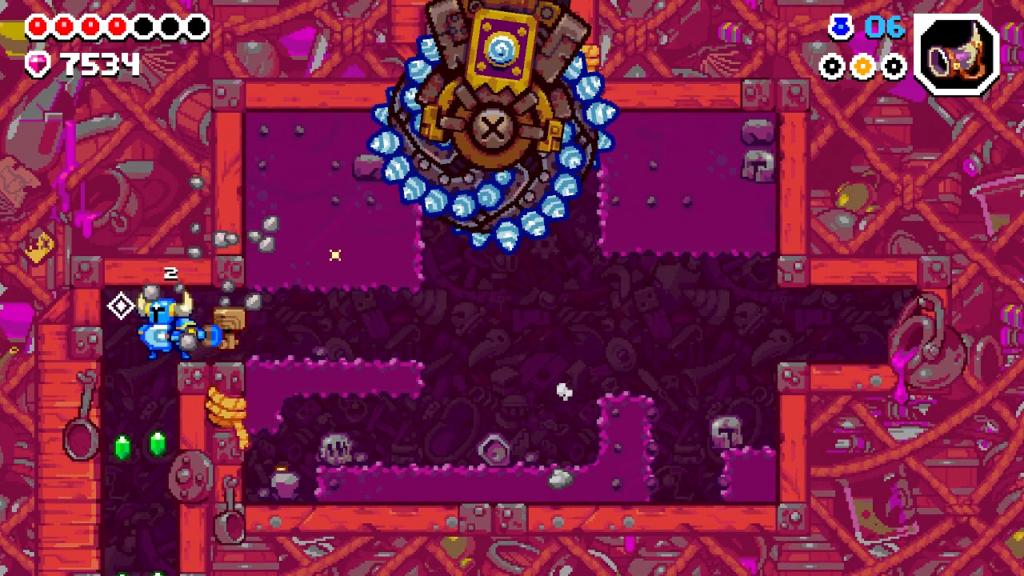
Where the Omega Saw feels most unwelcome is when trying to reclaim Shovel Knight’s dropped tools. Keys are needed to reach many of the most useful upgrades found across the Hexcavators’ Lair, but Shovel Knight drops them when he is struck by an enemy or obstacle. Running to pick up a dropped key only invites the Omega Saw’s wrath. More frustratingly, Shovel Knight cannot pick them up again until his short period of mercy invincibility wears off.
This means when an item is dropped on a set of spikes, it is effectively lost even as it glimmers beckoningly for Shovel Knight to reclaim it. Trying to touch it usually results in getting hit by the spikes and dropping the key again, trapping the player character in a punishing cycle of hurting until I give up. This is especially aggravating when a lost key is one of the Hoofman’s valuable Relic Keys.
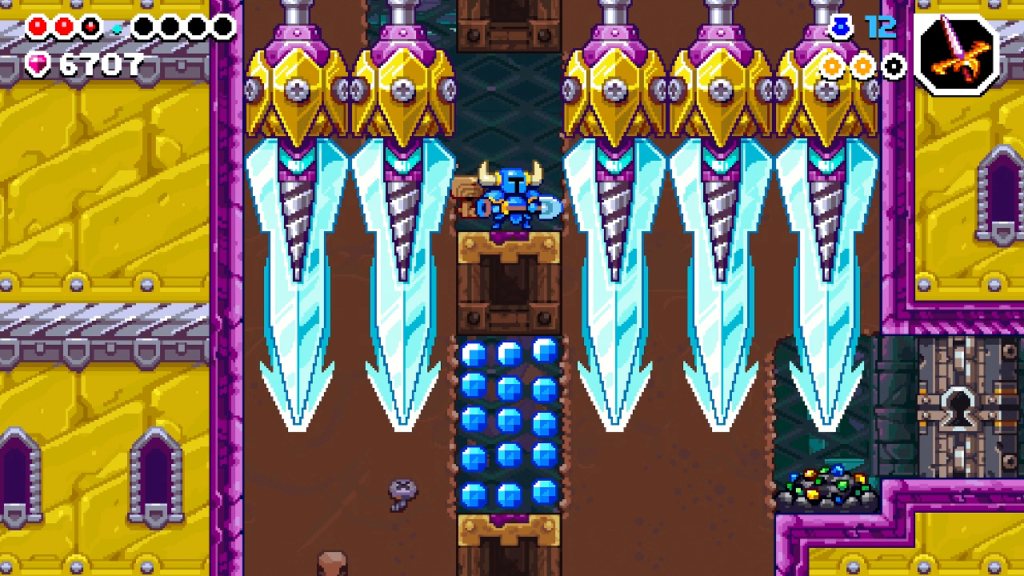
The deepest levels of the Hexcavator’s Lair punish every misplaced jump with a hit to Shovel Knight’s health cap. The best way to overcome these obstacles is to bolster his paltry starting health bar, but being a pseudo-procedurally generated videogame, my success at this goal is at the whim of randomly-appearing rewards and NPCs. Accessories like Fenix Feathers, which gives Shovel Knight an extra life, and the Overstuffin’ Muffin, which increases his health cap when he eats food at full health, are essential. Yet even with their help, every time I lead Shovel Knight to his death he loses these boons and returns to the Mushroom Mines with his default hit points.
My time with Shovel Knight Dig is typified by a growing sense of despair. The more I play it, the less I enjoy it. Many of the elements which make Shovel Knight appealing–the retro pixel graphics, the fun Mega Man-meets-Ducktales throwback design, and the eclectically weird characters–are all here. Yet it still feels like a hollow fabrication of Shovel Knight’s world than a true addition to it. Worse, it often feels arbitrarily difficult, my success at reaching Drill Knight at the Lair’s bottom seeming to depend more on finding an Overstuffin’ Muffin early on than playing especially well. Maybe I’m not skilled enough at platformers to meet Dig’s challenge. Maybe Dig isn’t a fun or fair platformer. I suspect it’s the latter.